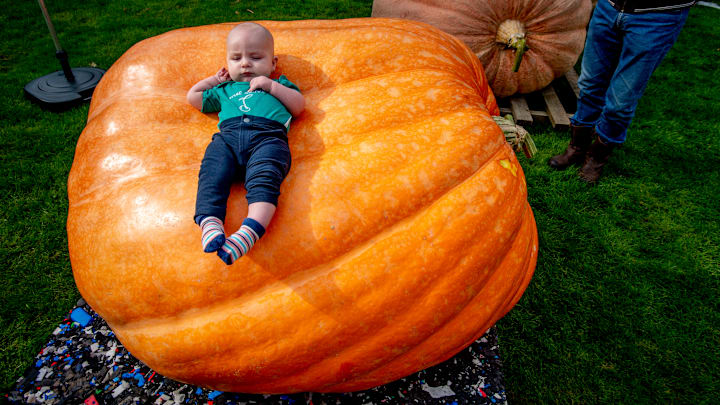Pumpkins can reach truly massive proportions. The Guinness World Record for heaviest pumpkin of all time belongs to a massive specimen that weighed 2749 pounds in 2023. If you’re looking for a gourd that rivals the world’s biggest, you won’t find it at the supermarket. The best way to get your hands on a giant pumpkin is by growing it yourself—and if you start now, it may be ready by Halloween 2026.
- Choose the right seed.
- Get your garden ready this fall.
- Start your seeds indoors.
- Pay attention to your soil and light.
- Know when to pluck the flower buds.
- Baby your giant pumpkin.
Choose the right seed.

A monster pumpkin starts with a tiny seed, but it can’t be any pumpkin seed. Modern Farmer recommends planting Dill’s Atlantic Giant—the variety that has produced nearly all the record-smashing pumpkins of recent decades. If grown under ideal conditions, these seeds can produce pumpkins between 300 and 500 pounds.
Get your garden ready this fall.

Start preparing to grow your giant pumpkin in the fall. In your garden, till a 10-foot-diameter bed that receives at least eight hours of sunlight per day. Spread six inches of composted manure over the soil and shape it into a low, wide mound. Cover the bed with straw mulch or a cover crop until you’re ready to plant your pumpkins in a few months.
Start your seeds indoors.

In late winter or early spring—roughly a month before the last frost of winter—germinate your pumpkin seeds in indoor pots. Air temperatures should fall between 65°F to 75°F and soil temperatures should be 70°F to 90°F. Once your seedling has sprouted a few leaves, plant it in the prepared bed in your garden. If you have more than one seedling, space them out at least 10 feet apart. Covering the area around the sprout with plastic in the early spring can protect it from cold weather and encourage early growth.
You Might Also Like ...
Pay attention to your soil and light.

Moisture, sun, and nutrients are essential to cultivating large pumpkins. The soil should always be moist, and the patch should be located in a bright, sunny spot without any shade. A weekly feeding of nutrients will help it gain a lot of bulk in a short amount of time. Wind, pests, and weeds pose a threat to pumpkins, so monitor the conditions around the plot and install a fence or use insecticides and fungicides if necessary.
Know when to pluck the flower buds.

Though it may seem counterintuitive, it’s important to pluck flower buds from your vine when it’s first starting to grow. This allows the leaves to grow big enough to collect energy for one, giant pumpkin instead of several tiny ones. When your vine is about 10 feet long, leave any budding flowers alone for a few weeks. The biggest fruit at the end of this period will be your giant pumpkin, and the rest can be pruned.
Baby your giant pumpkin.

Giant pumpkins have unique needs to keep in mind. They’re prone to rot, and a bed of sand or a sheet of wood or cardboard beneath them offers protection from moisture and insects. The skin of a 300-pound pumpkin is stretched to its limit, and erecting a shade cloth over the fruit keeps its exterior flexible as it expands. Also, make sure to prune any rootlets preventing the vine near the pumpkin from lifting off the ground as it grows larger. Branching vines that produce leaves promote growth, but vines that are longer than eight feet may consume more energy than they harness for the pumpkin and should be removed.
With some luck and hard work, your giant pumpkin should be ready to harvest by the end of fall. The crop won’t make very good pumpkin pie, but it might win you a blue ribbon at your local fair. Here are more uses for pumpkins of any size this autumn.
A version of this story originally ran in 2021; it has been updated for 2025.
